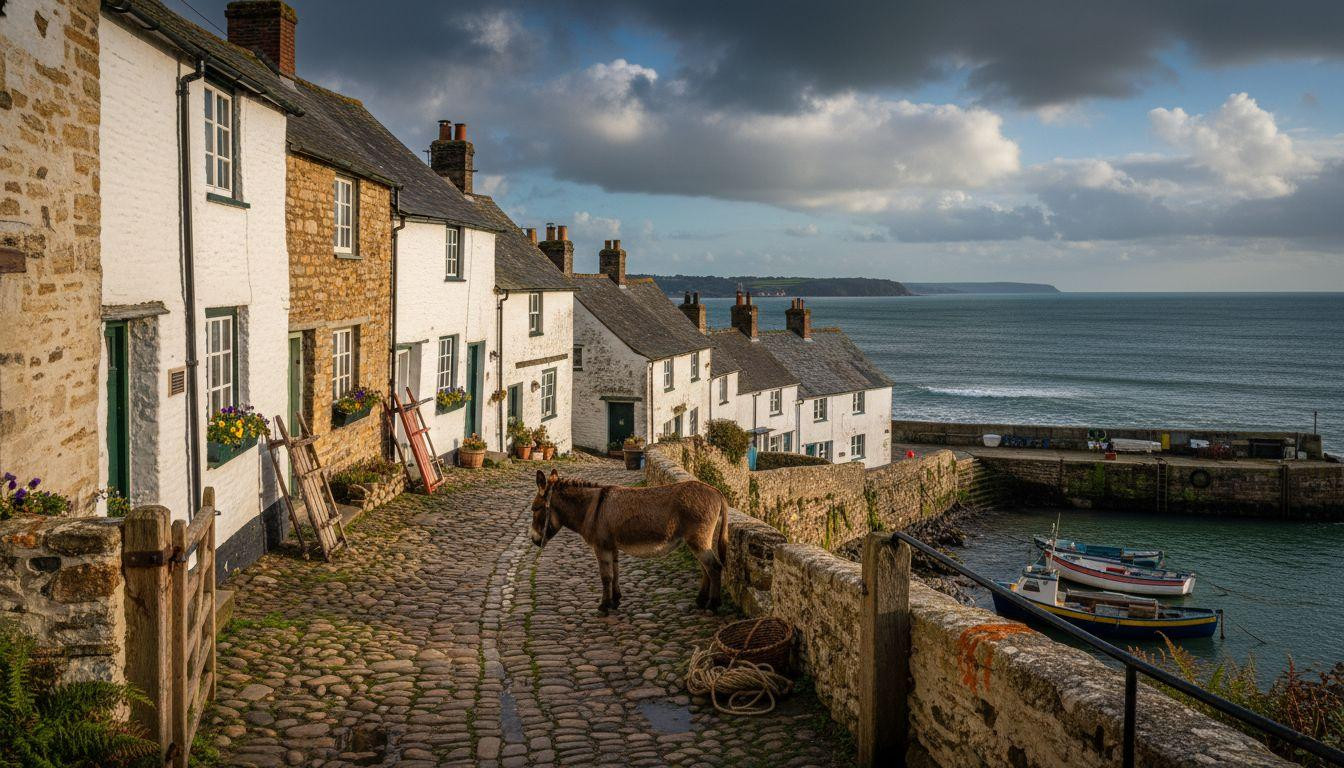At 6:47 AM, golden light touches whitewashed cottages cascading down impossible cobbles toward Bideford Bay. Steam rises from bakery windows while a rescue donkey waits patiently outside, wooden sledge strapped to its back. This is Clovelly in November 2025, where 443 residents live without cars on England’s most vertical fishing village. Private stewardship has preserved medieval logistics for 400 years. While Cornwall’s tourist villages charge $240+ per night 60 miles south, this Devon secret maintains authentic maritime rhythms at half the cost.
Where England’s cliff edge meets the sea
Clovelly clings to a 394-foot cliff on Devon’s north coast, 240 miles from London. The village descends 0.23 miles of cobbled street from visitor parking to the 14th-century harbor. The gradient proves so steep no vehicle has navigated it since the 16th century.
Bideford Bay spreads turquoise below while South West Coast Path winds past on clifftops. Three families have owned the manor since 1086: the Carys for 400 years, then the Hamlyn family from 1738 to present. This private ownership created preservation, not gentrification.
Entrance fees ($12 adults, $7 children) fund maintenance of honey-colored stone cottages and cobbled streets unchanged for centuries. This fishing port where Atlantic tides shift six times daily unchanged since 1500 shares similar maritime preservation just across the Channel.
The village where donkeys still deliver Amazon packages
When medieval logistics never ended
Wooden sledges scrape cobblestones each morning as donkeys transport goods from parking to harbor. No emergency exception exists. Ambulances stop at the top, patients carried by village Land Rover or stretcher.
Amazon deliveries arrive by sledge. Furniture moves on donkeys. This isn’t tourist theater but daily necessity on streets built for mules in 1550. The RNLI operated lifeboats here until 1988. Villagers now run their own rescue service, equipment hauled up 394 feet after each launch.
Architecture frozen by private stewardship
George Cary’s 16th-century stone breakwater and fish cellars survive alongside vernacular cottages with slate roofs and whitewashed walls. Recent restoration preserved rather than renovated. Flower boxes overflow with winter pansies, cobbles remain uneven, and the 400-year-old street pattern dictates modern life.
Clovelly Court Gardens crown the village, offering first clifftop views before descent begins. This village of 545 people glows amber on granite at dawn in Normandy showcases similar preserved stone architecture across the water.
What actually happens in England’s last car-free village
The descent most visitors miss
November strips away the 100,000+ summer visitors, revealing dawn magic. Golden light climbs limestone walls while mist rises from the harbor. The seasonal Land Rover taxi ($2.50) doesn’t run off-season.
Descent and 394-foot return climb become meditative reality. South West Coast Path extends both directions for clifftop hiking. The fisherman’s cottage museum and Kingsley Museum (Charles Kingsley lived here) open year-round with entrance ticket. This village of 977 people glows amber at sunset where Brittany tides shift six times daily offers comparable coastal walking opportunities.
Maritime flavors without Cornwall prices
Two village inns serve Devon seafood at $15-30 per meal versus Cornwall’s $42+ tourist menus. Local lobster, crab, and mackerel arrive fresh to the 14th-century quay. November’s Herring Festival celebrates the Atlantic catch that sustained the village for 600 years.
Craft workshops operate in restored fish cellars, included in entrance fee. The village bakery (operating 7:30-13:00 daily) produces famous Clovelly Cob bread. Steam stays visible from bakery windows until 10:30 AM.
The contrast nobody mentions
Port Isaac sits 30 miles south, where Doc Martin tourism packs narrow streets with selfie crowds. Polperro, 50 miles away, charges $10 parking plus inflated menu prices. Clovelly’s private ownership creates what Cornwall commercialized away.
Entrance fees keep visitor numbers sustainable while funding preservation. The 443 residents actually live here year-round, not weekend cottage owners. Dawn belongs to bakers and fishermen. Donkeys wait for genuine deliveries, not photo ops.
The cobbles remain uneven because they’ve been uneven since 1550. This is England’s last fishing village where medieval logistics govern modern Amazon deliveries. This moorland where 3,500 year old stone circles stand unguarded across 80 square miles provides the perfect inland contrast to coastal village exploration.
Your questions about this tiny village of Clovelly in England descends to the sea answered
How do you actually get there without a car?
Train to Barnstaple (20 miles away, connections from Exeter after flights to Exeter International 45 miles distant). Taxi costs $30-35 to Clovelly village parking. November trains run reduced schedules so confirm returns before descent. No Uber operates here. The 394-foot climb back requires 20-30 minutes of steady effort on cobbles.
What about those $12 entrance fees?
Entrance includes parking, visitor center, two museums, Clovelly Court Gardens access, craft workshop entry, and village maintenance. Budget accommodation starts $85/night in nearby villages versus $240+ in Cornwall’s Padstow or St. Ives. The entrance fee preserves what you’re paying to see.
When do the crowds actually leave?
October through March sees 80% fewer visitors than summer peak. November’s Herring Festival draws food-focused travelers, not tour buses. Dawn and late afternoon golden hours remain empty even in shoulder seasons. Visit weekday mornings for maximum peace.
At 4:08 PM in November, western light backlights the descending village, turning white cottages amber against deep turquoise harbor water. A donkey clip-clops up cobbles with empty panniers while fishing boats rock at the medieval quay below. England’s vertical village glows golden, suspended between cliff and sea.
